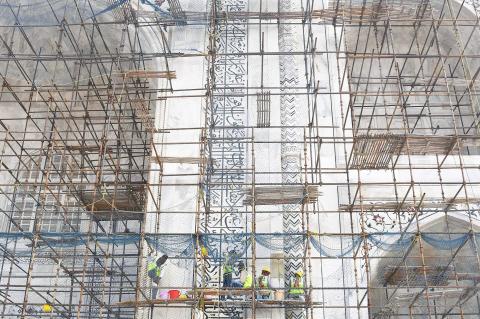Tourist Muskan Mahuwakar pictured the Taj Mahal as a dazzling vision of symmetry and beauty, but upon reaching the monument, she — like thousands of other visitors — was disappointed to find it covered in scaffolding, its once white marble now yellowing due to pollution.
Building restoration at India’s most popular tourist attraction is now into its fourth year, with work yet to even begin on its imposing dome.
“It’s disappointing not to get a perfect frame of this immaculate structure,” Mahuwakar, a history student, said on her first visit to the Taj, as nearby cleaners armed with colorful plastic buckets and large mops desperately tried to scrub some luster back into the stained stone.

Photo: AFP
Other restoration teams scale the facade, blocking views to the ornate Islamic carvings engraved on its walls — the interruption to the serenity of visiting one of the seven modern wonders of the world.
“The repair has been going on for so long. Of course, old monuments need to be conserved, but we must find solutions that are quick and effective,” Mahuwakar said, casting a dejected look at the scaffolding around.
Pollution and old age are taking their toll on the 17th-century mausoleum, nestled on the south bank of the Yamuna River in Agra, but critics warn that even the options authorities are using to try to fix might be exacerbating the problem.
Mudpacks have been applied in stages to draw out stains, but critics say the process is as damaging as bleaching the fine stone.
Authorities reject this, but admit they are concerned about how to proceed with handling the fragile central dome.
There are fears this inevitable work risks damaging the unmistakable feature of the Taj and will put off tourists.
Experts say the iron scaffolding risks leaving irrevocable scars on the fine marble, but bamboo frames are inadequate for such heights, leaving few options for those charged with executing the daunting task.
“We have to clean the dome, but the challenge is how to erect the scaffolding,” said Bhuvan Vikrama, the government archeologist overseeing restoration efforts.
“The structure is almost 400 years old, so we can’t put any extra load on it. In righting the wrong, we should not wrong the right,” he said.
It remains unclear when work will begin or for how long the central dome will be encased in scaffolding.
Fodor’s Travel, a publisher of tourism guidebooks, has advised readers to avoid the Taj until at least next year lest visitors be disappointed.
The number of local tourists is also being capped at 40,000 a day in a bid to reduce wear and tear on the monument to love, which was built by Mughal emperor Shah Jahan for his beloved wife. Mumtaz Mahal, who died giving birth in 1631.
Daily visitor numbers average 10,000 to 15,000, but can be much higher at weekends, going up to about 70,000.
According to government data, nearly 6.5 million people — mainly from India — visited the historic complex in 2016.
Anyone wanting to see the main crypt, which houses marble graves inlaid with semi-precious stones, will also have to pay for a pricier ticket.
However, critics warn that restoration is only half the solution, pointing to the industrial factories across the river that near continuously belch out noxious fumes, leaving the air thick with smog.
The toxic haze from this and from dung and garbage burning in and around Agra is responsible for discoloring the Taj, experts say.
Efforts to curb these pollutants, including banning motor vehicles within 500m of the building, have failed to clear up the air.
MC Mehta, a lawyer, said his battles in court to shift polluting industries — including a huge crematorium — had fallen on deaf ears.
“No one wants to take hard decisions,” Mehta said.
“The Taj used to be surrounded by lush greenery, but now there is nothing. Taj is in the last stage of cancer. It is dying, it is gasping for breath,” he said.

END OF AN ERA: The vote brings the curtain down on 20 years of socialist rule, which began in 2005 when Evo Morales, an indigenous coca farmer, was elected president A center-right senator and a right-wing former president are to advance to a run-off for Bolivia’s presidency after the first round of elections on Sunday, marking the end of two decades of leftist rule, preliminary official results showed. Bolivian Senator Rodrigo Paz was the surprise front-runner, with 32.15 percent of the vote cast in an election dominated by a deep economic crisis, results published by the electoral commission showed. He was followed by former Bolivian president Jorge “Tuto” Quiroga in second with 26.87 percent, according to results based on 92 percent of votes cast. Millionaire businessman Samuel Doria Medina, who had been tipped

ELECTION DISTRACTION? When attention shifted away from the fight against the militants to politics, losses and setbacks in the battlefield increased, an analyst said Recent clashes in Somalia’s semi-autonomous Jubaland region are alarming experts, exposing cracks in the country’s federal system and creating an opening for militant group al-Shabaab to gain ground. Following years of conflict, Somalia is a loose federation of five semi-autonomous member states — Puntland, Jubaland, Galmudug, Hirshabelle and South West — that maintain often fractious relations with the central government in the capital, Mogadishu. However, ahead of elections next year, Somalia has sought to assert control over its member states, which security analysts said has created gaps for al-Shabaab infiltration. Last week, two Somalian soldiers were killed in clashes between pro-government forces and

Ten cheetah cubs held in captivity since birth and destined for international wildlife trade markets have been rescued in Somaliland, a breakaway region of Somalia. They were all in stable condition despite all of them having been undernourished and limping due to being tied in captivity for months, said Laurie Marker, founder of the Cheetah Conservation Fund, which is caring for the cubs. One eight-month-old cub was unable to walk after been tied up for six months, while a five-month-old was “very malnourished [a bag of bones], with sores all over her body and full of botfly maggots which are under the

BRUSHED OFF: An ambassador to Australia previously said that Beijing does not see a reason to apologize for its naval exercises and military maneuvers in international areas China set off alarm bells in New Zealand when it dispatched powerful warships on unprecedented missions in the South Pacific without explanation, military documents showed. Beijing has spent years expanding its reach in the southern Pacific Ocean, courting island nations with new hospitals, freshly paved roads and generous offers of climate aid. However, these diplomatic efforts have increasingly been accompanied by more overt displays of military power. Three Chinese warships sailed the Tasman Sea between Australia and New Zealand in February, the first time such a task group had been sighted in those waters. “We have never seen vessels with this capability